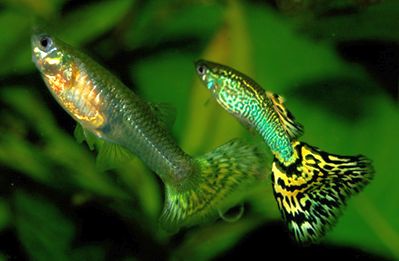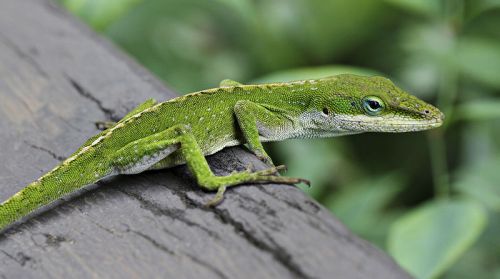Speedy species surprise
The rapid appearance today of new varieties of fish, lizards, and more defies evolutionary expectations … but fits perfectly with the Bible.

Researchers in Trinidad relocated guppies (Poecilia reticulata) from a waterfall pool teeming with predators to previously guppy-free pools above the falls where there was only one known possible predator (of small guppies only, therefore large guppies would be safe).1
The descendants of the transplanted guppies adjusted to their new circumstances by growing bigger, maturing later, and having fewer and bigger offspring.
The speed of these changes bewildered evolutionists, because their standard millions-of-years view is that the guppies would require long periods of time to adapt.
One evolutionist said, ‘The guppies adapted to their new environment in a mere four years—a rate of change some 10,000 to 10 million times faster than the average rates determined from the fossil record.’2
Leggy lizards
And it’s not just guppies. In the Bahamas, small numbers of anole lizards (Anolis sagrei) were transplanted from an island with tall trees to nearby islands where there were previously no lizards and only smaller bushy vegetation.
Body form rapidly changed in succeeding generations.3 In particular, the relative length of hindlimbs was greatly decreased—thought to be an adaptation for life amongst the twigs of the scrubby vegetation in the lizards’ new habitat. (Lizards that live on tree trunks have longer legs than those that live on twigs—an apparent trade-off between the agility necessary for twig-to-twig jumping and the speed that longer limbs provide on the broad surface of tree trunks.)4,5
But again it was the speed of adaptation, many thousands of times higher than (their interpretation of) the ‘fossil record’ that surprised evolutionists.6
Daisy diaspora
On small islands off British Columbia, the seeds of wind-dispersed weedy plants in the daisy family (Asteraceae) are rapidly losing their ability to ‘fly’. Specifically, the embryo part of the seed is becoming fatter while the parachute-like ‘pappus’ that keeps each seed aloft is becoming smaller. These changes are advantageous because they reduce dispersal—otherwise, on such tiny islands, lightweight windblown seeds would be lost in the ocean (which is why they have left fewer descendants). Note that these changes involve the loss of the capacity for long-range airborne dispersal.7
Flies, fish and finches
Other examples of rapid adaptation, even to the extent of producing ‘new species’—speciation—abound. (If a population arises from another which cannot interbreed anymore with its parent population, it is generally defined as a new species.)

Creation magazine recently reported how evolutionists described as ‘alarming’ the rate of change in the wingspan of European fruit flies introduced accidentally to America.8,9,10 Similarly, rapid changes have been reported recently for Drosophila fruit flies and sockeye salmon—within just nine and thirteen generations respectively.11
In the case of Darwin’s famous finches, it had been estimated that from one million to five million years would have been necessary for today’s Galapagos Island species to radiate from their parent populations. But actual observations of rapid finch adaptation have forced evolutionists to scale that back to a timeframe of just a few centuries.12
Mosquitoes and mice
Not long ago, evolutionists were astonished to find that bird-biting mosquitoes, which moved into the London Underground train network (and are now biting humans and rats instead), have already become a separate species.13 And now a study of house mice in Madeira (thought to have been introduced to the island following 15th century Portuguese settlement) has found that ‘several reproductively isolated chromosomal races’ (in effect, new ‘species’) have appeared in less than 500 years.14
In all of these instances, the speedy changes have nothing to do with the production of any new genes by mutation (the imagined mechanism of molecules-to-man evolution), but result mostly from selection of genes that already exist. Here we have real, observed evidence that (downhill) adaptive formation of new forms and species from the one created kind can take place rapidly. It doesn’t need millions of years.
Shouldn’t evolutionists rejoice, and creationists despair, at all this observed change? Hardly. Informed creationists have long stressed that natural selection can easily cause major variation in short time periods, by acting on the created genetic information already present. But this does not support the idea of evolution in the molecules-to-man sense, because no new information has been added.

Selection by itself gets rid of information, and of all observed mutations which have some effect on survival or function,15 so far even the rare ‘beneficial’ ones are also losses of information. The late-maturing, larger guppies resulted simply from a re-shuffling of existing genetic material.16 Such variation can even be sufficient to prevent two groups from interbreeding with each other any more, thus forming new ‘species’ by definition, without involving any new information.
The biblical account of history not only accommodates such rapid changes in body form, but actually requires that it would have happened much faster than evolutionists would expect. As the animals left the Ark, multiplying to fill the Earth and all those empty ecological niches, natural selection could easily have caused an original ‘dog kind’ (e.g.) on the Ark to ‘split’ into wolves, coyotes, dingoes, etc. Because there are historical records showing some of these subtypes in existence only a few hundred years after the Flood, this means that there had to have been some very rapid (non-evolutionary) speciation. So it is encouragingly supportive of biblical history when some such rapid changes are seen still occurring today.17 And this is being repeatedly confirmed.
But since evolutionists mistakenly interpret all such adaptation/speciation as ‘evolution happening’, they are left stunned when it happens much faster than their traditional interpretations of the fossil record would allow. (This is, of course, easy to understand when it is realized that the standard idea about the fossil record—that it is a ‘tape-recording’ of millions of years—is in fact a misinterpretation. The record reflects the way in which a global Flood and some of its after-effects buried a world of plants and animals in a time sequence which did not involve millions of years.)
Because such fast changes challenge traditional evolutionary ideas, the findings are often disputed, but with little success.2 Rapid ‘evolution’ (a misnomer, as we have seen) is welcomed by some fossil experts who support the idea of ‘punctuated equilibrium’.18 This is the notion that the evolutionary history of life is one of mostly no change, ‘punctuated’ by short, sharp bursts of evolution (which, conveniently, happen too briefly to be recorded in the fossils). However, not only is this still a minority view among evolutionists, it begs the question of why, if fast change is everywhere, has not a vastly greater number of new species been generated over ‘geologic time’? I.e. the observed changes are still too fast for comfort.
Not only is this rapid change not adding information, even some evolutionists point out that evolution in the molecules-to-man sense was not observed in any of these studies. The finches are still finches, the mosquitoes stay mosquitoes, and the mice remain mice. One evolutionary geneticist, referring to the guppy data, said, ‘As far as I know, these are still guppies’.2
Setting the record straight
If we start with the Word of the One who knows all, the evidence of today’s world makes a great deal of sense. Creatures were to reproduce ‘after their kind’, so mice come from mice, lizards from lizards, daisies from daisies. Evolution has never occurred, nor does it occur today. But organisms have a wonderful ‘built-in’ genetic capacity for rapid change in response to environmental pressures—most easily observed today in isolated island environments.
Such examples of rapid adaptation give us an insight into how the Earth’s many vacant ecological niches were recolonized after the Flood—a global event in real history. This event buried the ‘world that then was’ (2 Peter 3:6). Because this was already a fallen world, the fossils record death, suffering and disease. Because it was a created world, the fossil record consists of the remains of some creatures that no longer exist, and some that still do, but no sequence of one type changing by stages into a totally different type, whether slowly or quickly.
Re-posted on homepage: 19 October 2022
References and notes
- Reznick, D.N., Shaw, F.H., Rodd, F.H. and Shaw, R.G., Evaluation of the rate of evolution in natural populations of guppies (Poecilia reticulata), Science 275(5308):1934–1937, 1997. Return to text.
- Morell, V., Predator-free guppies take an evolutionary leap forward, Science 275(5308):1880, 1997. Return to text.
- Losos, J.B., Warheit, K.I. and Schoener, T.W., Adaptive differentiation following experimental island colonization in Anolis lizards, Nature 387(6628):70–73, 1997. Return to text.
- Case, T.J., Natural selection out on a limb, Nature 387(6628):15–16, 1997. Return to text.
- Morell, V., Catching lizards in the act of adapting, Science 276(5313):682–683, 1997. Return to text.
- Evolutionists have invented a unit called the ‘darwin’ for measuring the speed of change in the form (body size, leg length, etc.) of a species. In the case of the Anolis sagrei lizards, the rate of change ranged up to 2,117 darwins—whereas evolutionists had only ‘measured’ rates of 0.1 to 1.0 darwins over the ‘millions of years in the fossil record’. For the guppies in Trinidad, the rates were even higher: from 3,700 to 45,000 darwins. Artificial selection experiments on laboratory mice show rates of up to 200,000 darwins. (Ref. 2 and Ref. 4.) Return to text.
- In the insect world, too, the loss of genetic information for flight can be advantageous, as shown by the success of wingless beetles on windswept islands. See Wieland, C., Beetle bloopers, Creation 19(3):30, 1997. Return to text.
- Fruit flies spread wings, Creation 22(4):5, 2000. Return to text.
- Walker, M., Flying out of control—alien species can evolve at an alarming rate, New Scientist 165(2222):15, 2000. Return to text.
- Huey, R.B. et al., Rapid evolution of a geographic cline in size in an introduced fly, Science 287(5451):308–309, 2000. Return to text.
- Marchant, J., Darwin strikes back—one modern idea about evolution turns out to be wrong, New Scientist 168(2262):11, 2000. Return to text.
- Wieland, C., Darwin’s finches: evidence supporting rapid post-Flood ‘adaptation’, Creation 14(3):22–23, 1992. Return to text.
- As they were no longer able to interbreed with the surface bird-biting variety any more, Wieland, C., Brisk biters, Creation 21(2):41, 1999. Return to text.
- Britton-Davidian, J. et al., Rapid chromosomal evolution in island mice, Nature 403(6766):158, 2000. Return to text.
- Many mutations are ‘neutral’ in this sense, i.e. just meaningless gobbledygook, and are often described as ‘transparent to selection pressures’. For instance, the non-critical portion of the amino acid chain of some proteins can vary without apparently affecting the way the protein works. Return to text.
- The major variation being observed seems to be from small, isolated populations starting with a mere subset of the total genetic information (thus variability). Natural selection acts on this, as does genetic drift, i.e. the statistical tendency for some forms of genes to be lost within small populations by pure chance. Return to text.
- The ‘long-age creation’ ministry of Dr Hugh Ross, Reasons to Believe, not long ago devoted a radio program to their apparent denial of observed speciation, repeatedly accusing CMI of believing in ‘evolution’. They completely failed to understand the point we have been making for years about information. Evolution is allegedly capable of having ‘created’ a huge amount of new information by natural processes. Thus, one may have a ‘new species’ by some man-made definition, but if nothing new has been added to the pool of biological information (but rather that information has been decreased), it boggles the mind to see how that could support ‘real’ evolution. The real issue is of course that rapid speciation further highlights the non-necessity of their local-flood compromise of the Genesis record. Return to text.
- Stephen Jay Gould was probably the best-known exponent of this view. However, the majority of evolutionists hold to the classical neo-Darwinian view of ‘mostly slow-and-gradual’ evolution. A leading member of this camp reportedly said that Gould ‘should not be publicly criticized because he is at least on our side against the creationists’; see Creation 21(4):9, 1999. Return to text.








Readers’ comments
Comments are automatically closed 14 days after publication.